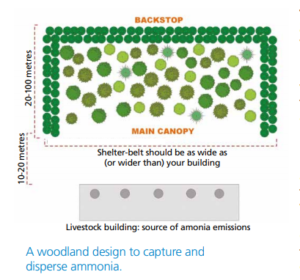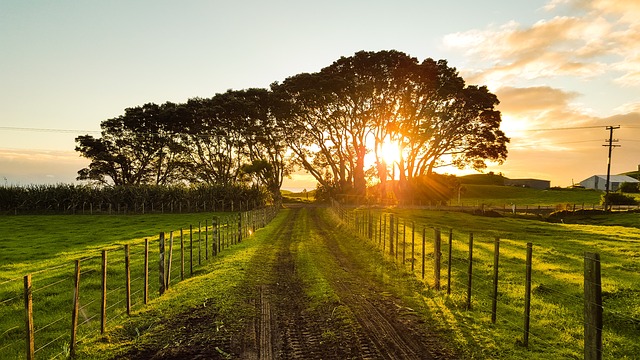Using woodlands to reduce ammonia emissions from animal housing
18 June 2019A new tool has been launched to help farmers plant trees to reduce ammonia emissions from animal housing. Trees can capture ammonia in the canopy and help disperse plumes of air pollution but it’s crucial to plant the right species in the right layout for this to be effective.
The guidance advises planting evergreen trees in a dense barrier around the edge of the belt, with more openly spaced ammonia capturing species between the barrier trees and the building (see diagram). When positioned down-wind of the building, this design effectively traps the emissions plume in the woodland, allowing the trees in the centre to soak up the ammonia. The Scottish Government’s Cleaner Air for Scotland strategy is currently under review and there is likely to be an increasing focus on cutting agricultural ammonia emissions. Ammonia from livestock can cause nitrogen to deposit into plants and soils. This can damage sensitive habitats, and cause soil acidification, leading to pollution of freshwater. Atmospheric ammonia pollution not only creates an unpleasant smell but its effect on air quality is harmful to human health.
Using this form of ammonia emissions mitigation also provides the additional benefits of planting trees. Creating shelter for livestock improves welfare and productivity, and introduces the potential to produce higher priced products such as woodland eggs. Trees around housing units also provide visual screening and landscape benefits, as well as carbon capture and biodiversity value. The tool will help foresters, land managers and farmers choose the best ammonia-capturing trees for the site. It was developed by Forest Research and the Centre for Ecology and Hydrology (CEH), and funded by SEPA. Non-profit organisation Grown in Britain has reported that prices for hardwood timber products have increased by 5 to 30% since 2017. The size of the increases varies between tree species and types of products, ie firewood, biomass, logs, sawn
planks but overall demand is currently very strong. The organisation believes that the UK’s undermanaged woodlands are a vast and valuable resource, calling on landowners to consider what might be ready to thin or fell. Active management not only provides a sustainable resource and income but improves the health of the wood, benefitting biodiversity and the wider environment.
Grown in Britain aims to increase the volume of UK timber meeting domestic and export demand by encouraging more and better management of woodlands. Firewood prices are being pushed up by increasing demand for biomass material, meaning that thinning or clear-felling even trees of small diameter or poor stem form can be profitable.
We’ve more information on farm woodlands on our webpage, alternatively, for help with woodland management and getting the most out of your trees contact the Farm Advisory Service for free advice either by phone on 0300 323 0161 or advice@fas.scot, open 9 am to 5 pm Monday to Friday.
This article has been published in the Spring 2019 edition of the Farm Woodland News. Download a copy to access all articles. Subscribe to receive newly published editions via email by using the form here.
Sign up to the FAS newsletter
Receive updates on news, events and publications from Scotland’s Farm Advisory Service

